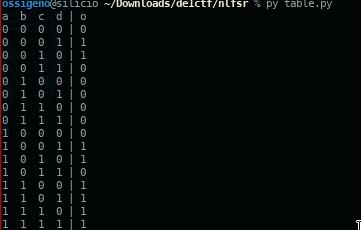Challenge
Information
- category: crypto
- points: 235
Description
Easy lfsr easy crypto
链接:https://share.weiyun.com/5qZbNLR 密码:n9huwc https://drive.google.com/open?id=1a5GMVZ77CM1rOrayKJcV3UvMwAy-uGsg
Writeup
Author
Solution
To understand how a general nlsr works, please read this article from ctfwiki. What did we learn from that article? That we must find a strong correlation between the output and one of the input. So we made a little script to retrieve the truth table of
(ao * bo) ^ (bo * co) ^ (bo * do) ^ co ^ do
The table retrieved is the following:

Is possible to see that the parameter A has a strong correlation with the output (75% of times, if A=0 then the output is 0). So we can calculate this value using the same approach described in the article mentioned before. I modified it slightly and the result is the following code:
mapA = {
(0,): 0
}
def lfsr(r, m):
output = ((r << 1) & 0xffffff) ^ (bin(r & m).count('1') % 2)
last_bit = (bin(r & m).count('1') % 2)
return output, last_bit
def guessA(maps: {}, rang, a, data, res):
ma= 0x505a1
old_a = a
for a in rang:
a = old_a
good = 0
total = 0
for j in range(0, len(data)):
to_check = ()
output = int(data[j])
a, a_bit = lfsr(a, ma)
to_check += (a_bit, )
expected_res = maps.get(to_check, None)
if expected_res is None:
continue
if expected_res == output:
good += 1
total += 1
if total != 0:
ratio = good * 100 / total
if ratio >= 70:
res.append(var)
return sorted(res, reverse=True)
This function will return the values of every number that has a correlation greater than 70, and only the value 363445 has this property Now we can retrieve the value of B. This is possible because, reading the truth table, if we know the value of A, and the output O, it is possible to bruteforce the value B having as constraints:
- If A is 1 and the output is 1, B must be 1.
- If A is 0 and the output is 0, B must be 1.
Again only 1 value comply with the constraints. At this point, we tried to find a correlation with C and D, having A,B and output. But we did not find any correlation, so we decided to bruteforce something. Since D are only ~40 values, we can try every value of D and use the complete truth table to retrieve the value of C for that particular D. Of course the last possible value of D was the right one, and thank to that we find the valid value for C. The values were: A=363445, B=494934, C=4406, D=63.